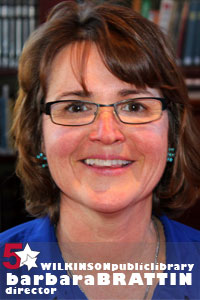
14 May BARB BRATTIN’S “FIVE STARS”: TRIBAL LEADERSHIP
Editor’s note: In 2011, for the fourth time in a row (and running), the Library Journal Index of Public Library Services, a public library rating system, designated Telluride’s Library a five-star institution. The Wilkinson Public Library ranked fifth in the nation among public libraries with annual budgets of $1 – 5 million, hence the name of library director Barb Brattin’s column.
Last week, Barb was on a soapbox about civility in anticipation of a workshop led by Jeff Goebel on the subject, coming up this weekend. The belief she shares with Jeff is this: through community, civility, and compassion, we can find the commonality in any group and use it as the foundation to restore peace and foster sustainability. Ideas such as that permeate Mountainfilm in Telluride, coming up Memeorial Day weekend. Barb’s next column about the nature of Tribal Leadership also anticipates Mountainfilm, where Stage 4 -type folks are the norm. Mark my words. And now Barb’s.
 I’ve been reading a book entitled “Tribal Leadership: Leveraging Natural Groups to Build a Thriving Organization” and it’s having quite an impact, not only in terms of how I view our internal organizational structure, but also on how Wilkinson Public Library would, in an ideal world, interact with the greater Telluride community.
I’ve been reading a book entitled “Tribal Leadership: Leveraging Natural Groups to Build a Thriving Organization” and it’s having quite an impact, not only in terms of how I view our internal organizational structure, but also on how Wilkinson Public Library would, in an ideal world, interact with the greater Telluride community.
The authors of “Tribal Leadership” are all partners in CultureSync, a consulting group specializing in strategy, cultural design, and high performance, three areas that should capture the attention of any organizational leader. Their book describes five stages, from the very dysfunctional “my life stinks and so does the organization” Stage 1 mentality to the superb “life is great” Stage 5 mind set. What holds my attention lies somewhere in between. My fascination dwells on the differences between what the authors describe as Stage 3 and Stage 4, and the techniques that move an organization between them.
In Stage 3, the authors contend, an organization is staffed with people possessed of the “I’m great” mentality. Under that scenario, the institution is a loose federation of a number of lone superstars competing with each other and viewing others as disappointments because they don’t demonstrate their skills or ambitions. Knowledge is power. Superstars hoard it. They complain they don’t have enough time or enough support, because they are “doing it all.” Forty-nine percent of the organizations studied by the authors were stuck in this stage.
The theme of Stage 4 is “We’re great.” Everyone in the organization identifies himself as a member of a group with a common purpose. Everyone commits to shared values and holds the others accountable to those values. Leaders feel pulled by the group. The authors describe Stage 4 organizations as thriving.
The gulf between Stage 3 and Stage 4 is enormous, and organizations who reach Stage 4 typically regress to Stage 3 now and again before climbing back up. Fully 75 percent of all organizations fall below the Stage 4 level and only 22% dwell in the nirvana of Stage 4 for any duration. The challenge for any leader to move his organization from Stage 3 to Stage 4 is great.
The primary tools to make the leap are twofold: Talk about core values every day. Describe everything in terms of “We.” The values we share are the basis for our decisions. We choose new staff members based on their commitment to our values. A staff member is disinvited to the group based on repeated violation of our shared values.
In the months to come, I’ll be observing the library’s relationship to the greater Telluride community, as well as our internal relationships, emphasizing these core values, hoping we land somewhere near Stage 4 – or at least on a fast track in that general direction.


Sorry, the comment form is closed at this time.